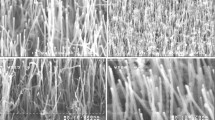Abstract
A study on the optimization of the method of application of the Ni catalyst for the growth of carbon nanotubes (CNTs) onto the gas diffusion layers (GDLs) (predominantly carbon cloths) by magnetron sputtering is presented. The mode of magnetron sputtering of the Ni catalyst which makes it possible to obtain a uniform metal coating on the GDLs which is required for the successful synthesis of CNTs is selected for the first time. It is shown that the sputtering of Ni in the direct current mode with the supply of pulsed bias voltage to the substrate with a frequency of 100 kHz and time of supply of the negative pulse of 7 µs makes it possible to obtain the optimum nanostructured coating of the metal with a low specific surface and a high degree of uniformity of application onto the entire area of the substrate. The applied Ni coating acts as the catalyst for the growth of CNTs. CNT arrays with the average diameters of 40 and 80 nm for the hydrophobic and hydrophilic GDLs, respectively, are grown on the GDLs with the applied Ni catalyst by pyrolytic gas-phase deposition. The CNT arrays are directly obtained on the entire surface of the carbon substrates with a high degree of uniformity. It is found that the diameter of the nanotubes is mainly determined by the structure of the GDL being used.



Similar content being viewed by others
REFERENCES
M. Guozhu, L. Xi, D. Huibin, et al., Renewable Sustainable Energy Rev. 48, 276 (2015). https://doi.org/10.1016/j.rser.2015.03.094
D. Chade, T. Miklis, and D. Dvorak, Renewable Energy 76, 204 (2015). https://doi.org/10.1016/j.renene.2014.11.023
C. Ghenai, M. Bettayeb, B. Brdjanin, and A. K. Hamid, Case Stud. Therm. Eng. 14, 100497 (2019). https://doi.org/10.1016/j.csite.2019.100497
H. Gwangwoo, K. K. Yong, B. K. Joong, et al., Appl. Energy 259, 114175 (2020).
N. A. Kelly, T. L. Gibson, and D. B. Ouwerkerk, Int. J. Hydrogen Energy 326, 15803 (2011). https://doi.org/10.1016/j.ijhydene.2011.08.058
R. Hanke-Rauschenbach, B. Bensmann, and P. Millet, Compendium of Hydrogen Energy, Vol. 1: Hydrogen Production and Purification, Ed. by V. Subramani, A. Basile, and T. Nejat Veziroglu, Woodhead Publ. Series in Energy (Woodhead, Oxford, 2015), p. 179. https://doi.org/10.1016/B978-1-78242-361-4.00007-8
M. S. Mamat, S. A. Grigoriev, K. A. Dzhus, et al., Int. J. Hydrogen Energy 35, 7580 (2010). https://doi.org/10.1016/j.ijhydene.2010.04.147
P. Mardle, X. Ji, J. Wu, et al., Appl. Catal. B 260, 118031 (2020). https://doi.org/10.1016/j.apcatb.2019.118031
Yu. V. Plekhanova, S. E. Tarasov, A. G. Bykov, N. V. Prisyazhnaya, T. Kh. Tenchurin, S. N. Chvalun, A. S. Orekhov, A. D. Shepelev, P. M. Gotovtsev, and A. N. Reshetilov, Nanotechnol. Russ. 13, 531 (2018).
A. Venkataraman, E. V. Amadi, Y. Chen, and C. Papadopoulos, Nanoscale Res. Lett. 14, 47 (2019). https://doi.org/10.1186/s11671-019-3046-3
A. V. Krestinin, Nanotechnol. Russ. 14, 411 (2019). https://doi.org/10.21517/1992-7223-2019-9-10-18-34
S. V. Bulyarskii, Carbon Nanotubes: Technology, Property Control, Application (Sterzhen’, Ul’yanovsk, 2011) [in Russian].
R. Z. Moghadam Esfahani, S. K. Vankova, and E. Bradley, Renewable Energy 154, 913 (2020). https://doi.org/10.1016/j.renene.2020.03.029
P. Chinnasa, W. Ponhan, and E. Swatsitang, Mater. Today: Proc. 17, 1344 (2019). https://doi.org/10.1016/j.matpr.2019.06.154
Y. Show and K. Takahashi, J. Power Sources 190, 322 (2009). https://doi.org/10.1016/j.jpowsour.2009.01.027
K. A. Shah and B. A. Tali, Mater. Sci. Semicond. Process. 41, 67 (2016). https://doi.org/10.1016/j.mssp.2015.08.013
J. Lin, Y. Yang, H. Zhang, et al., J. Alloys Compd. 745, 817 (2018). https://doi.org/10.1016/j.jallcom.2018.02.252
X. Wu, F. Mu, and H. Zhao, J. Mater. Sci. Technol. 55, 16 (2020). https://doi.org/10.1016/j.jmst.2019.05.063
A. V. Eletskii, Phys. Usp. 40, 899 (1997).
P. Salunke, S. Yarmolenko, S. Neralla, et al., in Proceedings of the 14th International Mechanical Engineering Congress IMECE 2007, Seattle, WA, USA, Nov. 11–15, 2007.
Z. Tang, C. K. Poh, Z. Tian, et al., Electrochim. Acta 56, 4327 (2011). https://doi.org/10.1016/j.electacta.2011.01.035
T. Thurakitseree and C. Pakpum, Appl. Mech. Mater. 891, 195 (2019). https://doi.org/10.4028/www.scientific.net/AMM.891.195
M. Baro, A. A. Hussain, and A. R. Pal, RSC Adv. 87, 46970 (2014). https://doi.org/10.1039/C4RA07833K
A. J. Hart, A. H. Slocum, and L. Royer, Carbon 44, 348 (2006). https://doi.org/10.1016/j.carbon.2005.07.008
S. A. Moshkalyov, A. L. Moreau, H. R. Guttierrez, et al., Mater. Sci. Eng. B 112, 147 (2004). https://doi.org/10.1016/j.mseb.2004.05.038
O. K. Alexeeva and V. N. Fateev, Altern. Energy Ecol., No. 7, 14 (2015). https://doi.org/10.15518/isjaee.2017.25-27.088-099
D. V. Sidelev and V. P. Krivobokov, Vacuum 160, 418 (2019). https://doi.org/10.1016/j.vacuum.2018.12.001
O. K. Alekseeva, A. I. Mikhalev, E. K. Lutikova, et al., Catalysts 8, 665 (2018). https://doi.org/10.3390/catal8120665
I. E. Baranov, V. I. Porembskii, E. K. Lyutikova, et al., Chem. Probl., No. 4, 489 (2019).
N. G. Chechenin, P. N. Chernykh, E. A. Vorobyeva, and O. S. Timofeev, Appl. Surf. Sci. 275, 217 (2013). https://doi.org/10.1016/j.apsusc.2012.12.162
N. A. Ivanova, O. K. Alekseeva, V. N. Fateev, et al., Int. J. Hydrogen Energy 44, 29529 (2019). https://doi.org/10.1016/j.ijhydene.2019.04.096
O. K. Alekseeva, A. I. Mikhalev, E. K. Lutikova, et al., Catalysts 8, 665 (2018). https://doi.org/10.3390/catal8120665
A. I. Kuz’michev, Magnetron Spray Systems, Vol. 1: Introduction to the Physics and Technology of Magnetron Sputtering (Avers, Kiev, 2008) [in RUssian].
A. Ostroverkh, V. Johánek, M. Dubau, et al., Int. J. Hydrogen Energy 44, 19344 (2019). https://doi.org/10.1016/j.ijhydene.2018.12.206
O. Guellatia, D. Béginb, F. Antoni, et al., Mater. Sci. Eng. B 231, 11 (2018). https://doi.org/10.1016/j.mseb.2018.03.001
Z. Xie, G. Guofen Chen, X. Yu, et al., Int. J. Hydrogen Energy 40, 8958 (2015). https://doi.org/10.1016/j.ijhydene.2015.04.129
J. Lin, Y. Yang, H. Zhang, et al., Ceram. Int. 46, 3837 (2020). https://doi.org/10.1016/j.ceramint.2019.10.107
H. Koji, H. Furuta, K. Sekiya, et al., Diamond Relat. Mater. 36, 1 (2013). https://doi.org/10.1016/j.diamond.2013.02.002
M. W. Lee, M. A. Haniff, A. S. Teh, et al., J. Exp. Nanosci. 10, 1232 (2014).
Funding
This work was supported by the Russian Foundation for Basic Research (project nos. 20-08-00927, 18-29-23030).
Author information
Authors and Affiliations
Corresponding author
Additional information
Translated by E. Boltukhina
Rights and permissions
About this article
Cite this article
Kudinova, E.S., Vorobyeva, E.A., Ivanova, N.A. et al. A Magnetron Sputtering Method for the Application of the Ni Catalyst for the Synthesis Process of Carbon Nanotube Arrays. Nanotechnol Russia 15, 715–722 (2020). https://doi.org/10.1134/S1995078020060129
Received:
Revised:
Accepted:
Published:
Issue Date:
DOI: https://doi.org/10.1134/S1995078020060129




